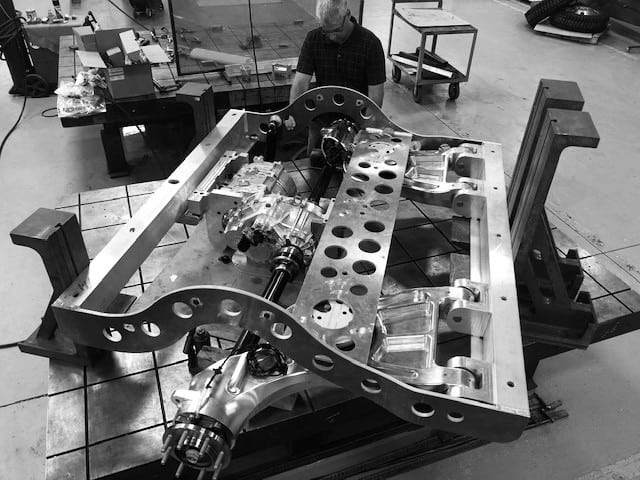Editor’s Note: Updates with details of Workhorse-Lordstown Motors intellectual property licensing agreement and Workhorse C-1000 delivery van
General Motors Co. (NYSE: GM) confirmed the sale of its shuttered Lordstown Assembly complex in northeast Ohio to startup Lordstown Motors Corp., which plans to build a battery-powered electric pickup truck focused on fleet customers.
Neither Lordstown Motors Corp. founder Steve Burns nor GM would disclose a sale price for the 6.2 million-square-foot plant that opened in 1966.
“The major fundraising starts today,” Burns told FreightWaves in a telephone interview Thursday. “People have spent billions to have a facility like this. Having a fully stocked physical asset like this is critical.”
People close to the situation previously estimated Burns would need $300 million to buy the plant and equipment and retool it for electric vehicle production.
“This plant can do 500,000 vehicles a year,” Burns said. “We’re not starting off with that.”
GM idled Lordstown in March after ceasing production of the compact Chevrolet Cruze sedan. Most of the 1,400 United Auto Workers-represented employees accepted jobs at other facilities, GM said.
Burns is counting on those who stayed in the area to become a highly skilled labor pool to staff the plant.
Political explosion
The fate of Lordstown exploded as a political issue in May when President Donald Trump tweeted that GM was selling the plant to Cincinnati-based Workhorse Group Inc. (NASDAQ: WKHS), preserving jobs in Ohio’s Mahoning Valley that helped him win the state in the 2016 election.
After weeks of confusion, it became clear that financially struggling Workhorse was not the buyer but that its technology was integral to a startup led by Burns, who founded Workhorse and was its CEO until February 2019.
The attention boosted little-known Workhorse shares from less than $1 to more than $4 in August before retreating. Shares closed up 27% at $3.18 on Nov. 7.
Trump criticized GM CEO Mary Barra, saying she should find a way to keep the plant open. The issue became a focal point of negotiations between the automaker and the UAW, which struck for six weeks — the longest national strike against GM since 1970 — before ratifying a new four-year contract Oct. 25. GM won the right to close Lordstown.
“GM is committed to future investment and job growth in Ohio and we believe LMC’s plan to launch the Endurance electric pickup has the potential to create a significant number of jobs and help the Lordstown area grow into a manufacturing hub for electrification,” the company said in a Nov. 7 statement.
The plant’s status moved from “unallocated” to “closed” under the new contract. That allowed the sale and ended UAW rights as the bargaining representative there.
“Lordstown Motors has indicated they may want to work with the UAW there,” GM spokesman Jim Cain told FreightWaves.
New team
Since stepping down from leading Workhorse, Burns has assembled a 60-person engineering team to get the electric pickup through prototype, crash testing and validation.
Engineers from Ford Motor Co., Volkswagen, Tesla and GM are involved, he said. In September, Burns hired Rich Schmidt as chief production officer. Schmidt directed Tesla Inc. manufacturing operations from 2012 to 2016.
“We’ve been running for eight or nine months working on the recipe for the truck,” Burns said.
Workhorse received a 10% ownership stake in Lordstown Motors and commissions on van sales as part of an intellectual property licensing agreement related to Workhorse’s W-15 electric pickup. It also will get a 4% commission on the gross sales price of 6,000 pre-orders of personal use W-15 pickups transferred to Lordstown Motors.
Postal possibilities
A technology tie-up between Lordstown Motors and Workhorse along with Trump’s ongoing interest in Lordstown could help steer a multiyear, $6 billion contract to build the next-generation U.S. Postal Service delivery vehicle in Lordstown. Workhorse and its partner V.T. Hackney are among four finalists for the contract. The USPS has delayed awarding the contract until 2020.
Burns’ focus is on the Endurance truck. Unlike electric pickups from Rivian and Tesla, which plans to reveal its consumer-focused electric pickup Nov. 21, Lordstown Motors is focused on the commercial market, such as landscapers and utilities.
“Fleets buy on total cost of ownership,” Burns said. “We are planning a price that is less than the least expensive truck you can buy.”
Workhorse delivery vans
Separately, Workhorse conducted test drives on Nov. 5 in Ohio for its C-1000 electric delivery van, formerly known as the NGEN-1000.
In the new name, the “C” stands for a composite body structure, which combined with its battery packs and electric driveline. Workhorse claims the C-1000 cuts more than 4,000 pounds from the mass of a comparable conventional internal combustion vehicle with the same 1,000 cubic feet of cargo volume and payload.
The delivery vans will be assembled at a 60,000-square-foot Workhorse plant in Union City, Indiana. Workhorse had 1,100 orders for the vans, including United Parcel Service (NYSE: UPS). The vans also will come in smaller 650-cubic-foot versions.








